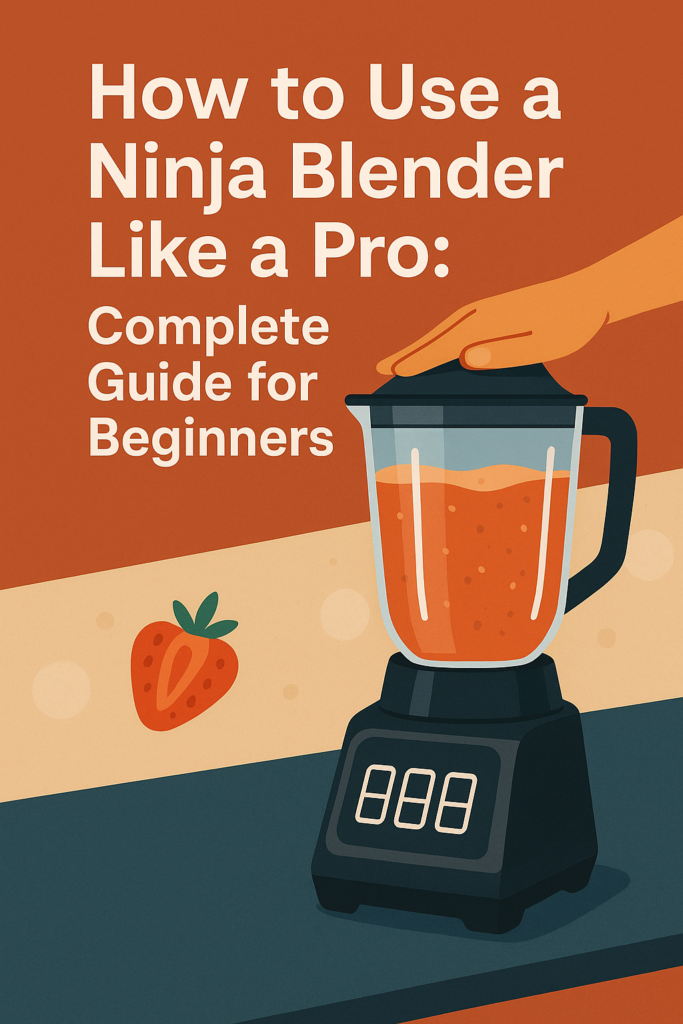
If you’ve recently purchased a Ninja blender or are considering adding one to your kitchen, you’re in for a treat. The Ninja blender is one of the most powerful and versatile blenders on the market. Whether you’re whipping up smoothies, soups, sauces or grinding up ice, these machines are built to do the job.
But to get the most out of your Ninja blender, it’s important to understand how to use it properly. In this handy beginners’ guide, we’ll walk you through everything from setup to cleaning, plus some expert tips to help you blend like a pro.
What Comes With a Ninja Blender?
When you unpack your Ninja blender, you may find different accessories depending on the model. However, most standard kits include:
The motor base (the main unit with the power button)
A pitcher or blending cup
A set of blades (stacked or extractor type)
A lid for the pitcher or a sip and seal lid for the cup
The instruction manual and sometimes a recipe book
Before using your blender for the first time, wash all removable parts (except the motor base) with warm, soapy water and let them dry thoroughly.
Knowing the parts
Understanding the main components will help you feel confident about using your blender:Motor Base: This is the central unit of the blender. Set the motor base on a stable, dry surface. It houses the motor and control panel. Some models have simple high/low/pulse options, while others include Auto-iQ presets.
Blender pitcher or cup: This is where you place your ingredients. Use the larger pitcher for large batches and the cup for single servings.
Blades: These are specially designed for powerful blending. Stacked blade assemblies are common in pitchers, while extractor blades are usually found in single-serve cups.
Lid and spout: Pitcher lids usually lock in place and include a pouring spout or vent cap. Single-serve lids often come with a flip-top spout for easy drinking.
How to assemble your Ninja blender
Set the motor base on a clean, level surface.
Choose a blending container (cup or pitcher) and fill it with ingredients. Always follow the maximum fill line.
If you’re using a pitcher, place the blades in first, then add your ingredients.
Close the lid tightly. For safety, most Ninja models won’t turn on unless the lid is properly locked in place.
Attach the pitcher or cup to the base. Turn it until it clicks (for cups) or the handle locks (for pitchers).
Always make sure everything is securely in place before turning on the blender.
Blending with presets vs. manual controls
Ninja blenders come with a variety of control options:
Manual controls: These include buttons like low, medium, high, and pulse. Use these for more control, especially when blending in stages or handling thick mixtures.
Auto-iQ technology: This smart feature is available on many Ninja models. It includes preprogrammed settings for smoothies, frozen drinks, purees, or ice crushing. Simply press the appropriate button and let the blender adjust the speed and time automatically.
For beginners, Auto-iQ can be a great way to get consistent results without having to guess how long or how quickly to blend.
What can you make in a Ninja blender?
Your Ninja blender isn’t just for smoothies. Here are some common uses:
Protein shakes and green smoothies
Nut butters like peanut or almond butter
Sauces like pesto, salsa or tomato puree
Pancake and waffle batter
Soups (hot or cold, depending on the model)
Crushed ice for frozen drinks or cocktails
Baby food and purees
Chopped vegetables for quick meal prep
Be sure to check your model’s manual for any specific recommendations or limitations.
Pro tips for best results:
Layer your ingredients correctly: Add liquids first, then soft items (like yogurt or bananas), and lastly hard ingredients (like ice or frozen fruit). This makes the blades move more smoothly and prevents jamming.
Don’t overfill: Always respect the maximum fill line. Overfilling can cause leaks, pressure buildup or motor stress.
Use the pulse feature: For chunky textures like salsa or chopped nuts, pulse the blender in short bursts rather than running it continuously.
Add liquid if needed: If your mixture is too thick or sticky, turn off the blender and add some water, milk, or juice to thicken the mixture.
Close the lid tightly: Ninja blenders are powerful. A loose lid can cause accidents.

Cleaning your Ninja blender
Cleaning is easy if you do it right away. Follow these steps:
Unplug the motor base.
Remove the pitcher or cup from the base.
Carefully remove the blade assembly.
Rinse all removable parts under warm water or wash them in the dishwasher (top rack only).
For a deeper clean, fill the pitcher halfway with warm water and a drop of dish soap. Pulse or blend on low speed for 30 seconds, then rinse thoroughly.
Wipe the motor base with a damp cloth. Never immerse it in water.
Tip: Never leave food in the blender for too long after use. It is difficult to clean once it dries and sticks.
Common mistakes to avoid
Running the blender continuously for too long. Allow the motor to cool down between extended blending cycles.
Using the wrong blade or container. Match the right blade to the right jar or cup.
Trying to blend very hard or hot items that your model is not rated for. This could damage the blade or container.
Ignoring the lock mechanism. If the lid or pitcher is not locked properly, the blender may not turn on.
Who Gives a Crap Toilet Paper – Is It Really Worth the Hype?
Penzeys Spices Review 2025: Are They Really Worth the Hype?
Best Electric Lunch Boxes in 2025 – Hot Meals on the Go
